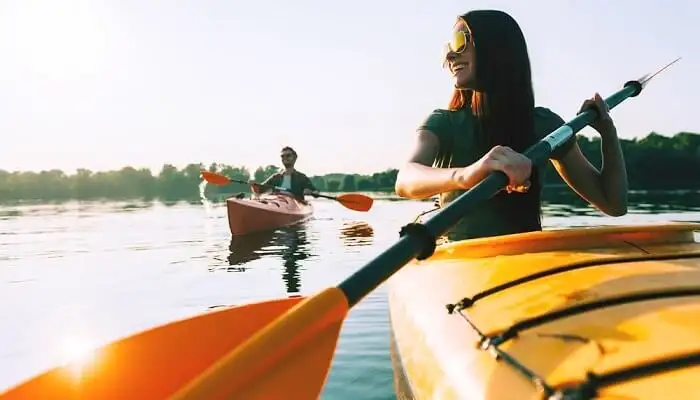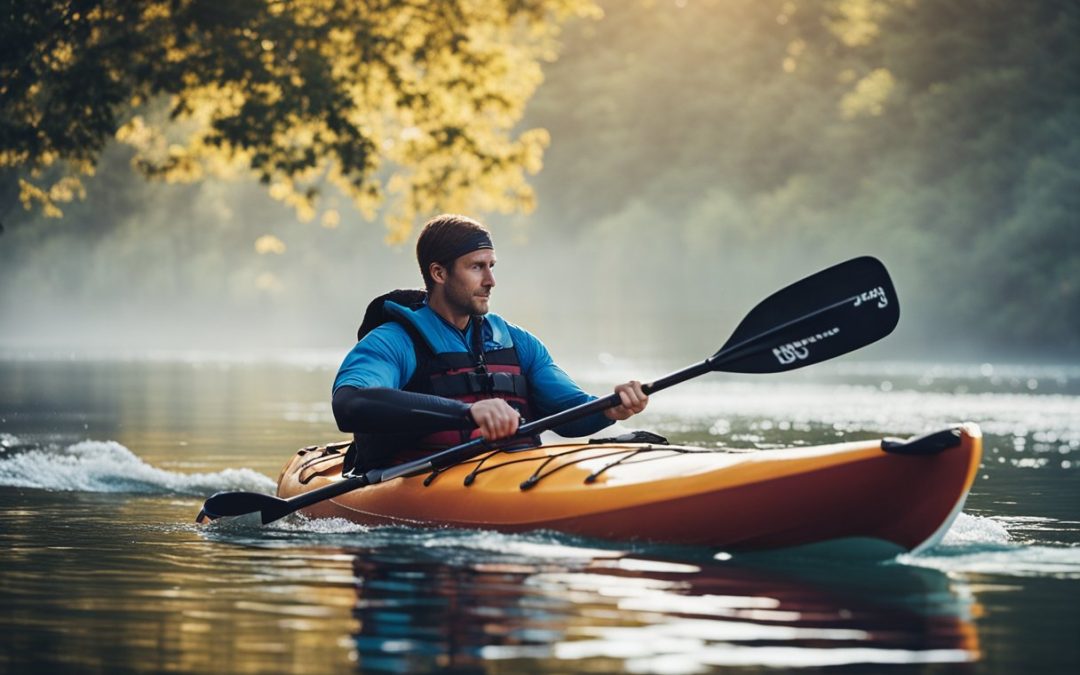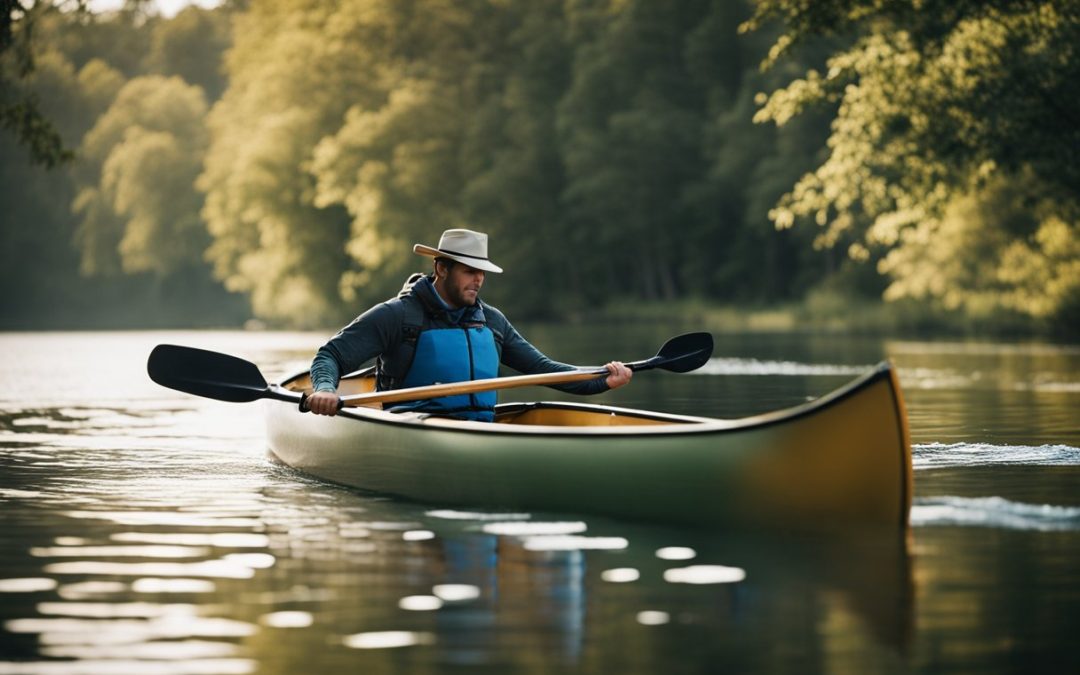Personal flotation devices (PFDs) play a crucial role in ensuring safety during kayaking, as they provide buoyancy to help individuals stay afloat in the water. Whether you’re a seasoned kayaker or a beginner, understanding the different types of PFDs, their designs, and features, as well as selecting the right one for your specific needs, is essential for a safe and enjoyable experience on the water. Additionally, complying with legal regulations and learning how to properly care for your PFD will guarantee its effectiveness and longevity.
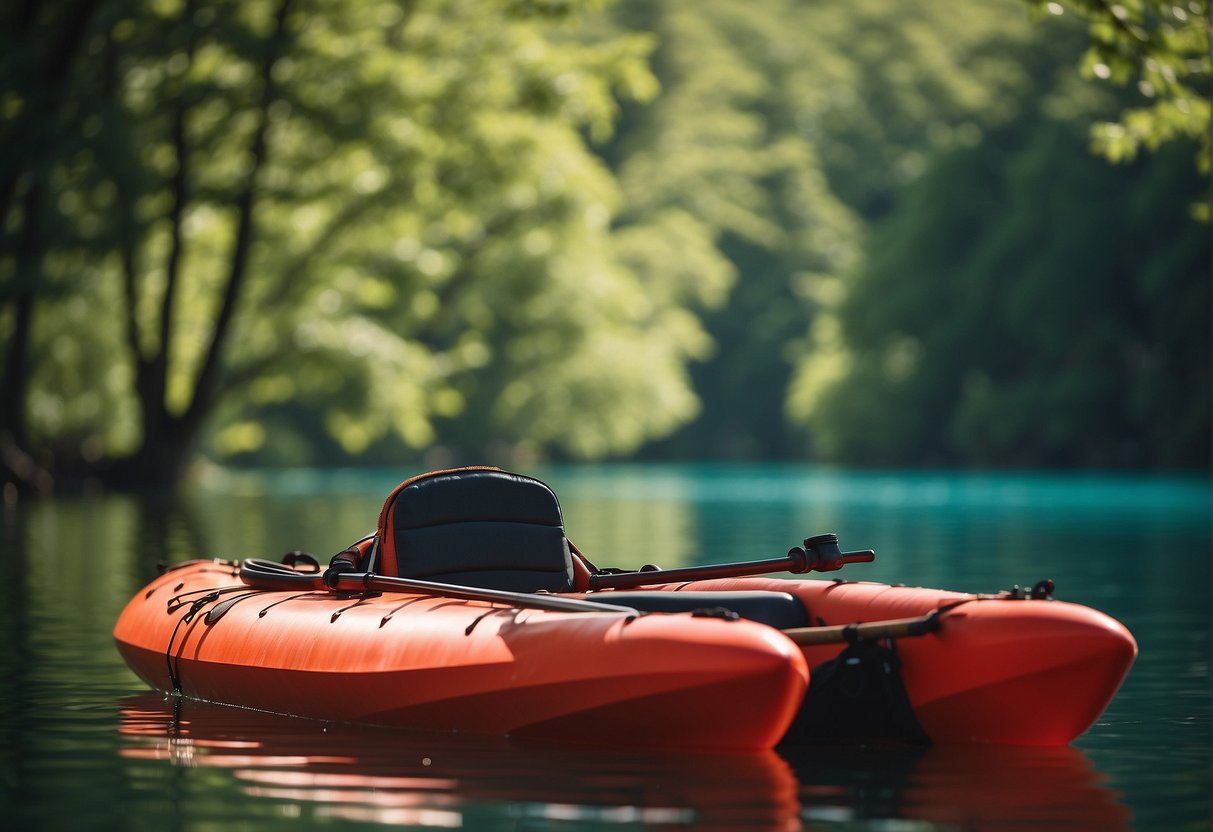
When it comes to selecting a PFD for kayaking, a variety of factors come into play. These factors include the type of kayaking activity, personal preferences, budget, and environmental considerations. With advancements in PFD technology and a focus on inclusivity, there are options available to suit every kayaker’s needs, making it more accessible and enjoyable for everyone.
Key Takeaways
- Importance of PFDs in ensuring safety during kayaking activities
- Selecting the appropriate PFD based on various factors, such as type of activity and personal preferences
- Advancements in PFD technology make kayaking more accessible and enjoyable for everyone
Understanding Personal Flotation Devices
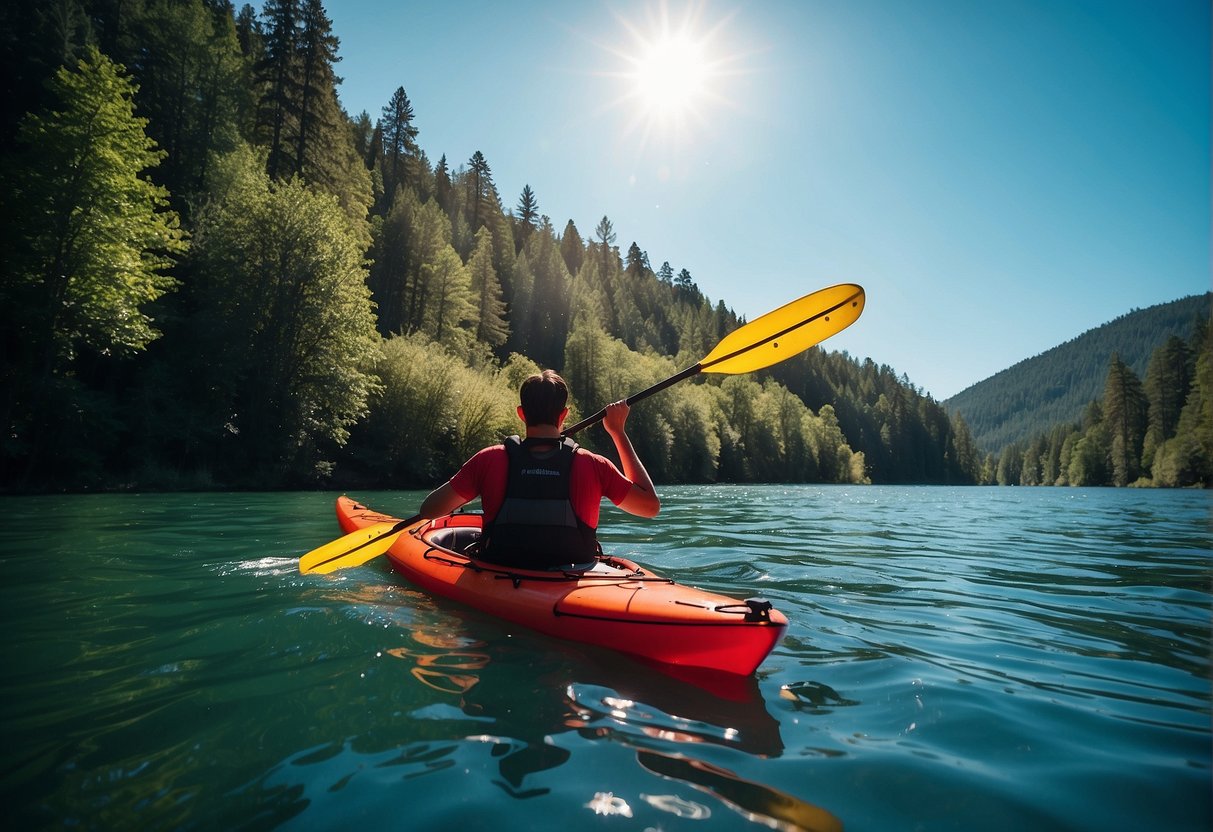
History and Evolution of PFDs
The concept of personal flotation devices (PFDs) dates back centuries, with early versions crafted from natural materials like animal bladders or plants with buoyant properties. Over time, PFDs have evolved to incorporate advanced materials, making them more effective, comfortable, and useful in a variety of water-based activities, including kayaking. At present, PFDs come in different forms, like life jackets and vests, providing buoyancy and helping users stay afloat in water.
Types of PFDs
PFDs are classified into five types by the US Coast Guard, each with unique characteristics and usage:
-
Type I PFD (Offshore Life Jacket): Designed for open, rough, or remote waters where rescue may be slow to arrive, this PFD offers the highest buoyancy and turns unconscious wearers face-up.
-
Type II PFD (Near-shore Buoyant Vest): Suitable for calm, inland waters or areas with a faster rescue response, these PFDs offer lower buoyancy than Type I and may not turn unconscious wearers face-up.
-
Type III PFD (Flotation Aid): Designed for comfort and freedom of movement during water activities like kayaking, these PFDs have less buoyancy than Type II but offer the same likelihood of turning an unconscious wearer face-up.
-
Type IV PFD (Throwable Device): This category includes buoyant cushions, ring buoys, and other throwable flotation devices used in case of emergencies or to assist non-swimmers.
-
Type V PFD (Special-use Device): These PFDs are designed for specific activities, such as kayaking, canoer and stand-up paddle boarding, and must be worn at all times to offer their full protection. Users must carefully read and follow the instructions provided with Type V PFDs, as they may not be suitable for all water activities.
US Coast Guard Regulations
The U.S. Coast Guard certifies and regulates PFDs to ensure their effectiveness in various situations. All PFDs should have a label indicating the USCG classification, user size, and weight capacity, along with maintenance and inspection guidelines. It is essential to choose a PFD that meets the USCG requirements for the specific activity and location being conducted. For example, kayakers should opt for a Type III or Type V PFD that provides both comfort and safety in their intended environment.
Design and Features of Kayak PFDs
Material and Durability
Kayak PFDs are made of durable materials like nylon and polyester to ensure long-lasting use. Mesh is often used to provide breathability while maintaining structural integrity. A high-quality PFD should have strong stitching to avoid fraying, and a durable construction capable of withstanding harsh environments related to water sports. Some popular kayaking PFDs known for their resilience include the NRS Ninja and the Astral YTV.
PFD Styles and Fits
There are various styles and fits to choose from, such as front-zip, side-zip, and over-the-head types. Selecting the right PFD can make a significant difference in both comfort and safety. Kayak PFDs are designed to have a snug fit with adjustable straps, allowing for maximum flexibility and a secure fit. Some PFDs, like the Astral Layla and Astral Ronny, cater to specific body shapes for increased comfort and better fit.
Comfort and Mobility Features
To ensure optimal comfort, many kayak PFDs offer features such as wide armholes for an increased range of motion, low-profile designs that don’t restrict movement, and well-positioned straps to enhance comfort. Breathable materials, such as mesh, are also used in PFD designs to maintain proper air circulation. The NRS cVest Mesh Back and NRS Vapor are examples of PFDs with added comfort and mobility benefits.
Additional Storage Options
Modern kayak PFDs frequently incorporate storage options like zippered pockets and D-rings for attachment points. These features provide added convenience, allowing kayakers to store essential items such as keys, sunglasses, and whistles without compromising safety. Bright colors are also common in PFD design, such as the Onyx MoveVent Dynamic Paddle Sports Life Vest, to enhance visibility and improve safety on the water.
Selecting the Right PFD for Kayaking
Sizing and Fit Considerations
Selecting the correct size and fit for your personal flotation device (PFD) is vital for kayaking safety and comfort. A well-fitted PFD ensures efficient buoyancy, allowing you to stay afloat in water. To find your ideal size, follow these key points:
- Measure your chest circumference: PFDs are sized based on chest measurements rather than weight, as with life jackets for other water sports.
- Adjustable fit: Choose a PFD with adjustable straps that can achieve a snug, secure fit around your body.
- Universal or unisex: Many kayak life vests are designed to be universal or unisex, fitting a wide range of body types.
- Test the PFD: Try on your PFD before entering the water, ensuring that it does not ride up and can be easily adjusted.
When trying out a PFD, it’s essential that it fits snugly yet comfortably, without restricting your movement or causing discomfort.
Choosing for Different Water Activities
Depending on your planned kayaking activities, the type of PFD you choose will vary. PFDs are available in different styles, each catering to specific water activities.
-
Recreational kayaking: For casual kayaking or canoeing, a Type III PFD will suffice. These PFDs offer sufficient buoyancy and are lightweight, making them suitable for calm waters and short trips. Some of the best PFDs for kayaking have been designed with comfort and maximum movement in mind.
-
Touring: When embarking on long-distance kayaking excursions, additional features become vital. PFDs featuring pockets for storage, high-visibility colors, and reflective material for enhanced safety are recommended for such activities. The Astral V-Eight is an example of a versatile PFD that caters to various kayaking adventures, including touring.
-
Different water conditions: Paddle boarding or engaging in other water sports may require a PFD offering different levels of buoyancy. It is advisable to consult expert advice on how to choose a PFD based on the specific water activity and conditions you may encounter.
Choosing the right PFD for your kayaking adventures involves taking into consideration your body size, water activities, and required performance features. By prioritizing safety, you can make the most of your time on the water.
Safety Features and Considerations
When it comes to kayaking, safety should be a top priority. A personal flotation device (PFD) plays a crucial role in ensuring a person’s safety while on the water. In this section, we will discuss some important safety features and considerations for PFDs, including visibility and color, and rescue readiness.
Visibility and Color
A PFD’s visibility is a vital factor in ensuring safety on the water. Bright colors, such as neon yellow, orange, or red, are highly recommended as they make it easier for rescuers and other boaters to spot the wearer. Some PFDs are also equipped with reflective materials to enhance visibility during low-light situations or nighttime. The US Coast Guard recommends a USCG Type III PFD for most recreational kayakers, as they provide a good balance between buoyancy and comfort.
Rescue Readiness
Apart from visibility, it is essential to consider the rescue features offered by a PFD. Some essential kayak safety gear that could be integrated into a PFD includes:
- Whistle: Attached to the PFD, a whistle can be used to signal for help in case of an emergency. One blast is for attention, while three blasts indicate the need for assistance.
- Strobe Attachment: Some PFDs come with an attachment point for a strobe light, which can be a lifesaver during nighttime or low visibility situations.
- Rescue Tether: A rescue tether allows the kayaker to be pulled back into their boat or secure themselves to another vessel during a rescue operation.
In addition to these features, it is crucial to ensure that the PFD fits snugly and is adjusted correctly to maximize its effectiveness. Regular inspection of the PFD and its safety features is also highly recommended, as boating fatalities often occur due to inadequate or improperly used safety gear. By carefully considering these safety features and maintaining your PFD, you can enjoy a safer and more enjoyable kayaking experience.
PFDs for Specific Kayaking Activities
Fishing PFDs
When it comes to fishing, having a PFD with ample storage is essential. Pockets provide space for keeping essential tools and tackle within easy reach. The NRS Chinook is an excellent example of a fishing-specific PFD, loved by anglers for its organization and functionality. Fishing PFDs also tend to prioritize comfort, often featuring mesh back panels for breathability, especially when seated against a kayak’s high backrest.
Key features for fishing PFDs include:
- Pockets: For storing tackle and tools
- Mesh back: Improves breathability and comfort while seated
- Low profile: Allows for a wide range of motion
Touring and Sea Kayaking
For touring and sea kayaking, durability and lightweight construction are paramount. A good PFD must endure constant exposure to sun, salt, and water, while not weighing down the paddler. Some of the best touring PFDs prioritize long-lasting materials and sleek designs to minimize bulk, allowing for easy movement and efficient paddling. Reflective elements are also important in touring PFDs for increased visibility in open water scenarios.
Essential features for touring and sea kayaking PFDs are:
- Lightweight: Enhances comfort over longer paddling distances
- Durability: Prolongs the PFD’s lifespan in harsh conditions
- Reflective elements: Increases visibility during daytime and nighttime
Whitewater Kayaking
Whitewater kayaking demands a PFD built for safety and maneuverability in fast-moving water. A low profile design allows the paddler to navigate through tight spaces, while the buoyancy ensures reliable flotation in rapids. Some of the top whitewater PFDs achieve lightweight construction without sacrificing safety features like quick-release belts and reinforced straps.
Important attributes for whitewater kayaking PFDs include:
- Low profile: Provides unobstructed movement and maneuverability
- Buoyancy: Ensures flotation in turbulent water
- Safety features: Quick-release belts and reinforced straps for added security
Care and Maintenance of PFDs
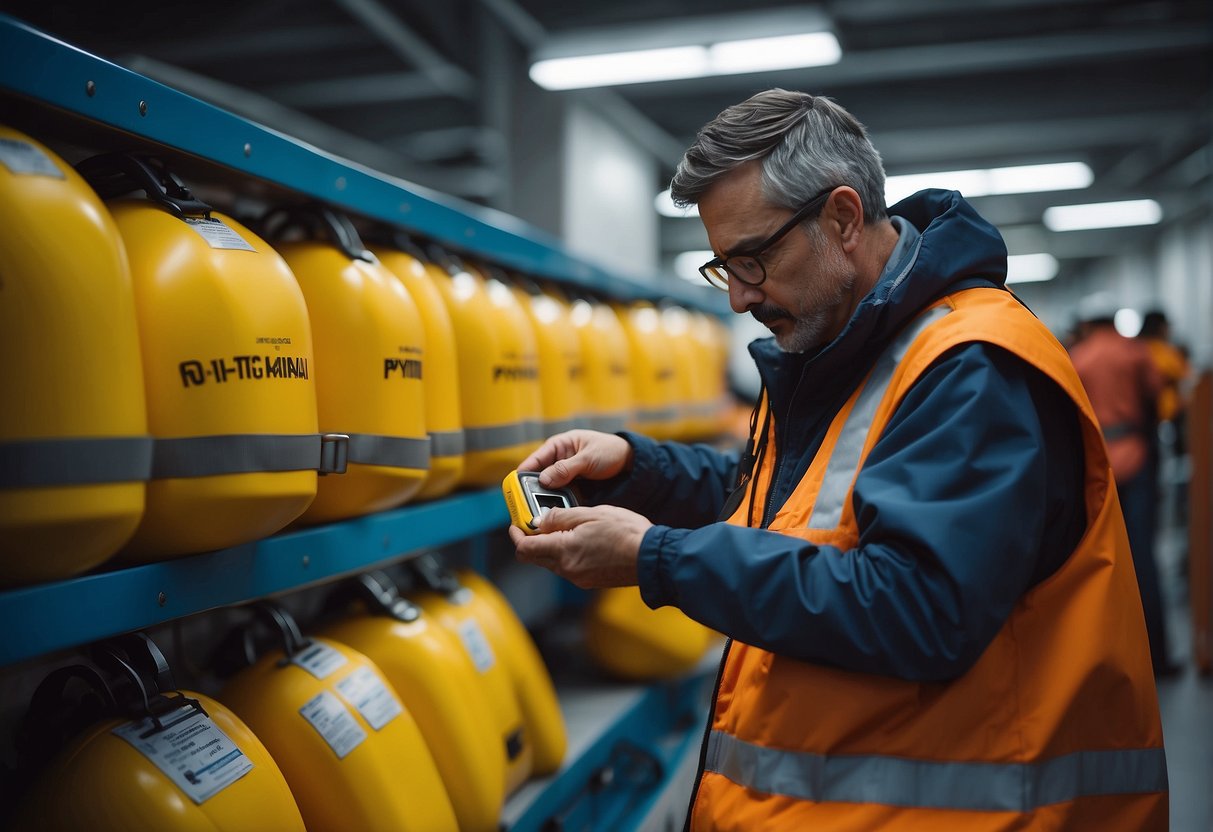
Cleaning Your PFD
To maintain your PFD’s durability and functionality, it’s crucial to clean it regularly. Rinse the PFD thoroughly with fresh water after each use to remove salt, chlorine, or other debris. For a more in-depth cleaning, soak the PFD in a mild soapy solution and gently scrub it using a soft brush. It is crucial to avoid using harsh detergents or bleach, which can damage the materials and affect its buoyancy. After cleaning, be sure to rinse the device thoroughly again with fresh water.
Storage and Handling
Proper storage and handling are essential for maximizing the lifespan of your PFD. Ensure that it is completely dry before storing it to prevent mold and mildew growth. Store the PFD in a cool, dry, and well-ventilated area away from direct sunlight and extreme temperatures, which could degrade the material.
When handling your PFD, avoid exposing it to sharp objects or abrasive surfaces, as this could lead to punctures or tears. Additionally, refrain from using it as a cushion or kneeling pad, which can put unnecessary stress on the material and reduce its buoyancy.
Inspection and Replacement
Regular inspection is crucial to ensure the safety and performance of your PFD. At least once a year, perform a thorough visual inspection to check for signs of wear, tears, or fraying. Moreover, examine hardware such as straps, buckles, and zippers for proper functioning and possible damage.
For inflatable PFDs, check the CO2 cylinder to ensure it is in good condition, and if it has a replaceable cartridge, make sure to replace it according to the manufacturer’s guidelines. Additionally, perform a leak test by inflating the device manually and ensuring it holds air for at least 16 hours.
Timely replacement of any damaged equipment is essential for maintaining the highest level of safety. If your PFD shows signs of wear or damage, or if it no longer provides adequate buoyancy, it is time to invest in a new one. Regular care and maintenance, combined with vigilant inspections, will ensure that your PFD remains reliable and effective during your kayaking adventures.
Environmental Considerations and Sustainability

Eco-Friendly Materials
When it comes to personal flotation devices (PFDs) for kayaking, it is essential to consider the impact of the materials on the environment. The use of eco-friendly materials in PFDs is becoming increasingly popular in an effort to promote sustainability. Many manufacturers are now offering PFDs made from organic and recycled materials, such as fabrics derived from recycled plastics, which help reduce waste and conserve natural resources.
In addition to using recycled materials, some PFDs also incorporate materials designed to have minimal impact on aquatic ecosystems. For instance, certain PFDs utilize chemical-free dyes that reduce water pollution, and some use natural fibers like hemp or bamboo that are biodegradable and contribute to a more sustainable manufacturing process.
Recycling Old PFDs
Recycling old PFDs is another crucial aspect of promoting environmental sustainability. It is important to dispose of old or damaged PFDs responsibly to prevent them from ending up in landfills or polluting our oceans. Many PFD manufacturers and outdoor gear companies have introduced take-back programs that allow customers to return their used PFDs for recycling.
Here are some tips for recycling old PFDs:
- Check the manufacturer’s website: See if they have a recycling program or guidelines for disposing of their products.
- Donation: If your PFD is still functional, consider donating it to a local community center, youth organization, or outdoor club.
- Upcycle: Get creative and upcycle old PFDs into useful items such as bags, cushions, or pet toys.
By paying attention to the materials used in PFDs and recycling old ones, kayakers can be more conscious of their impact on the environment and contribute to a sustainable future. It is important, regardless of the activity, to always be mindful of our planet and promote eco-friendly practices whenever possible.
Legal and Regulatory Compliance

When it comes to kayaking, ensuring that you are in compliance with legal and regulatory requirements for personal floatation devices (PFDs) is essential for your safety on the water.
USCG PFD Requirements
In the United States, the US Coast Guard (USCG) is responsible for regulating PFDs and sets the requirements for their use. According to 33 CFR § 175.15, every person on board a recreational vessel must have access to at least one wearable PFD. Each PFD is to be used in accordance with any requirements on its approval label and any guidelines in its owner’s manual if the label refers to such a manual.
PFDs are also categorized under a USCG rating system. This system groups PFDs into different types based on their buoyancy, intended use, and performance characteristics. Here is a brief overview of the USCG types:
- Type I: Offshore life jackets, providing the highest buoyancy
- Type II: Near-shore buoyant vests, suited for calmer waters
- Type III: Flotation aids, offering less buoyancy but more comfort
- Type IV: Throwable devices, such as ring buoys or seat cushions
- Type V: Special-use devices, designed for specific activities.
While the regulations vary by state, kayaking rules often require that PFDs be worn or at least easily accessible on board.
International Standards
Outside the United States, PFD regulations may differ. For example, in Canada, Transport Canada is responsible for PFD regulations. According to the Transport Canada guidelines, PFDs must be Canadian-approved and adhere to specific requirements, such as having a label that indicates the PFD type and size.
Regardless of location, it is also essential to consider international standards. The International Organization for Standardization (ISO) provides guidelines to ensure PFDs meet necessary safety and quality benchmarks.
While legal and regulatory requirements for PFDs are essential for kayaking safety, make sure to also bring along some snacks and water to help keep your energy up while paddling. Knowing the rules surrounding PFDs and having proper equipment can help ensure a safe and enjoyable kayaking experience.
Advancements and Innovations in PFD Technology

In recent years, the Personal Flotation Device (PFD) industry has undergone significant advancements and innovations, leading to the development of smarter and more efficient devices for water sports enthusiasts, such as kayakers.
Smart PFDs
With the integration of technology into PFDs, smart PFDs are now becoming a popular choice among kayakers. These devices are designed to provide more functionality and enhanced safety features. They often include:
- GPS tracking systems: To help locate the wearer in case of emergencies.
- Automated alarms: Triggered when the wearer enters the water, alerting nearby individuals or rescue teams.
- Integrated communication systems: Allowing the wearer to communicate with others during an emergency or requiring assistance.
Smart PFDs not only improve the user’s safety on the water but also add an extra layer of convenience and peace of mind.
Inflatable PFD Technology
Inflatable PFDs have gained popularity in recent years due to their compact design and improved versatility. These devices utilize a CO2 cylinder to inflate the PFD quickly when needed, providing instant buoyancy. Inflatable PFD technology offers several advantages:
- Lightweight and comfortable: With their less bulky design, they allow for more freedom of movement, making them ideal for kayaking and other water sports.
- Manual and automatic inflation: Many inflatable PFDs offer both manual inflation (by pulling a cord) and automatic inflation (by water-activated sensors), ensuring quick and efficient use in emergencies.
- Reusability: The CO2 cylinder can be easily replaced after each use, making the inflatable PFD a cost-effective and environmentally friendly option.
In conclusion, the advancements in PFD technology, such as smart PFDs and inflatable PFDs, have contributed to increased safety, convenience, and versatility for kayakers. As innovations continue to emerge, the world of personal flotation devices is expected to become even more efficient and tailored to the needs of water sports enthusiasts.
Choosing the Best PFDs for Different Budgets
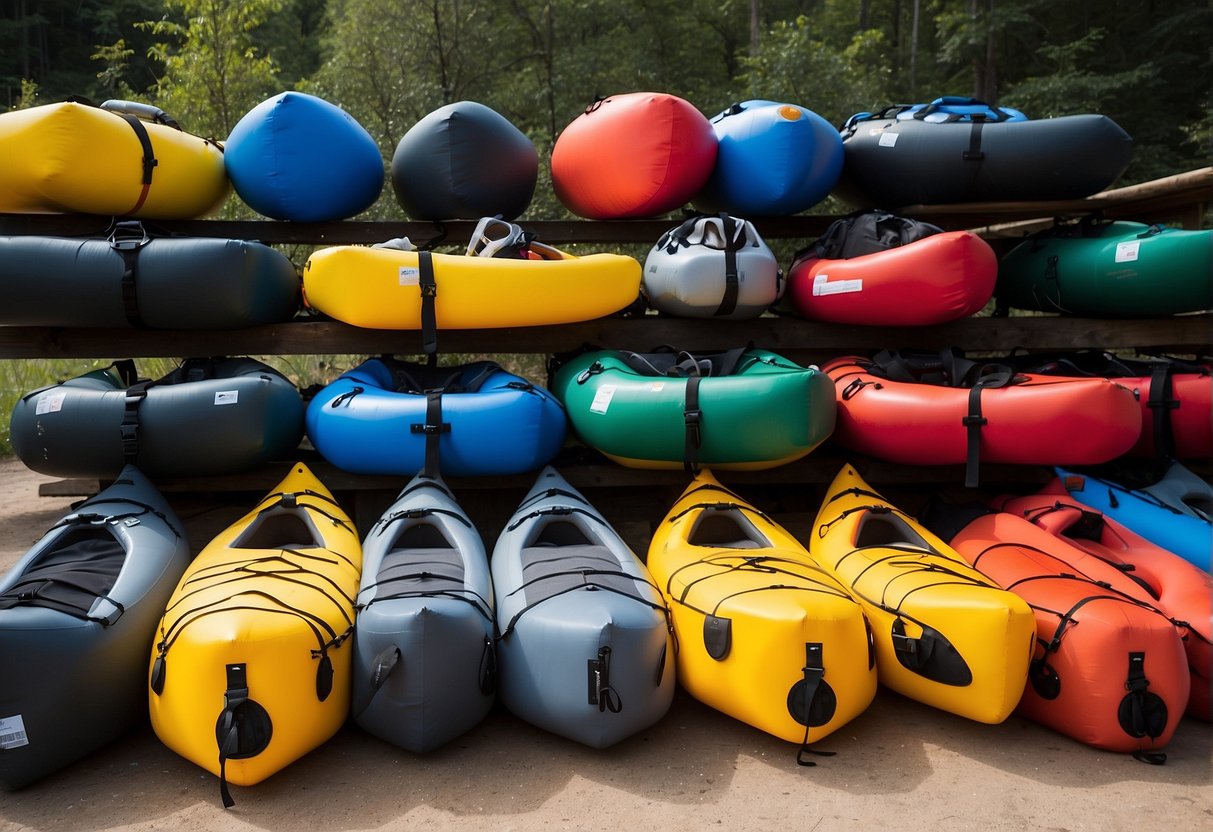
When looking for the best PFDs (personal flotation devices) for kayaking, one must take into consideration both the budget and the value for money. In this section, we will discuss two categories of PFDs, which include economical options and investment pieces.
Economical Options
For those on a budget, there are several affordable PFD options that provide decent safety and comfort while kayaking.
-
ONYX MoveVent: This PFD is known for its high-quality design and comfortable fit. The mesh ventilation and adjustable straps allow for a customized and comfortable experience. The ONYX MoveVent is often praised for its value for money as it is an affordable option compared to higher-end PFDs.
-
NRS Vista: Another economical choice is the NRS Vista, which offers a basic design and functionality at a reasonable price. It is a reliable option for recreational kayakers who are looking for a no-frills yet safe PFD.
Investment Pieces
If you’re willing to invest in a higher-priced PFD, there are a few options that provide exceptional features and comfort, making them an excellent investment in the long run.
-
Kokatat: The Kokatat brand offers several high-end PFDs that are specifically designed for kayaking. Their models focus on safety, durability, and comfort – all crucial factors when kayaking. Kokatat PFDs come with features like front pockets, multiple adjustment points, and reflective tape for increased visibility.
-
Astral Green Jacket: Another premium PFD option is the Astral Green Jacket, which is designed for rescue purposes but can also be used for kayaking. It features reinforced shoulder straps, storage pockets, and a quick-release rescue harness. The high-quality materials and design make this PFD an investment piece that will last for years.
Remember, when choosing the best PFD, it ultimately comes down to personal preference and budget. Both economical and investment options provide safety and different levels of comfort while kayaking. It’s essential to try on different PFDs before purchasing to ensure the perfect fit for your needs.
PFDs for All: Ensuring Inclusivity
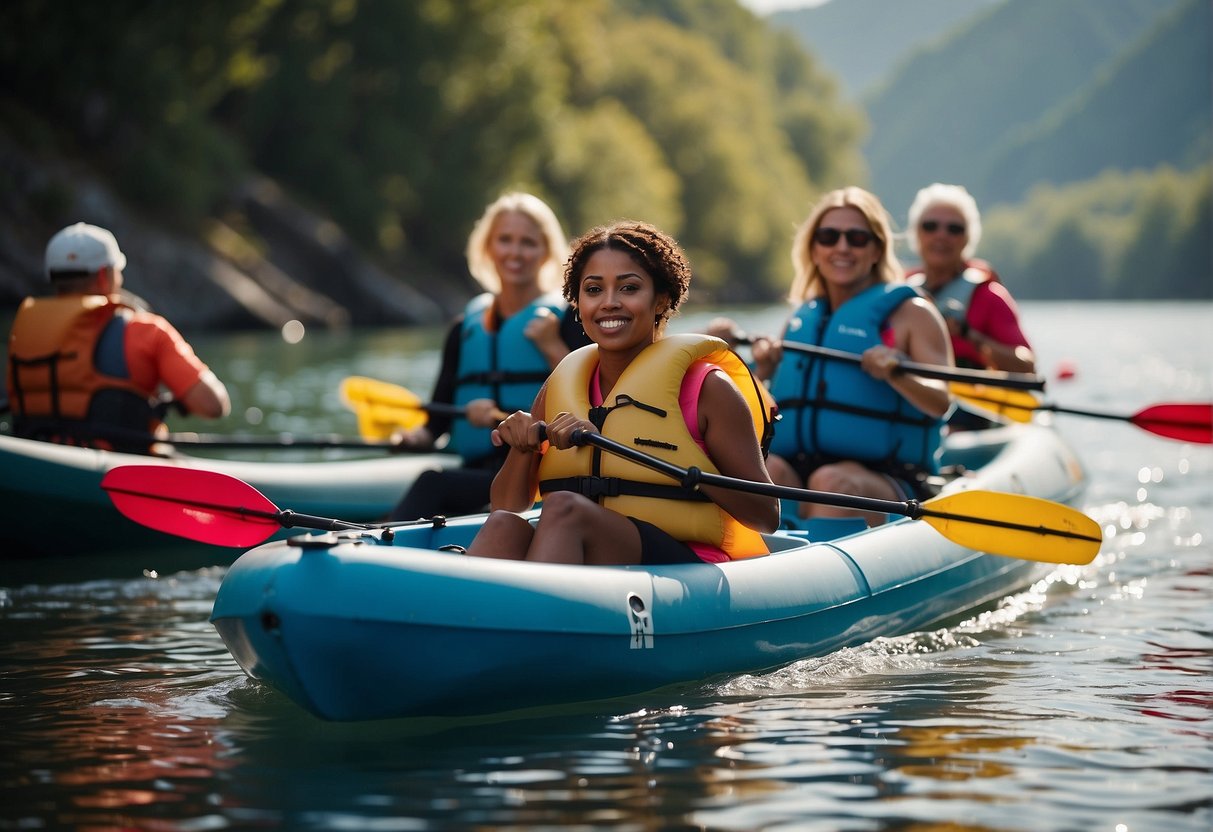
PFDs for Women
When it comes to personal flotation devices (PFDs) for women, it is crucial to find options with a comfortable and secure fit. Many PFDs offer a unisex design that accommodates a wide range of users. However, there are also women-specific PFDs that feature adjustable straps and a selective fit system to ensure comfort and safety. A popular PFD for women is the Astral Layla, which is designed with a unique multi-panel foam construction that contours to the female body. Another great option is the Onyx MoveVent, a versatile PFD with a sculpted foam design for maximum mobility and comfort.
Children and Youth PFDs
Ensuring the safety of younger kayakers is a top priority, and there are PFDs specifically designed for children and youths. These PFDs come in appropriate sizes and are tailored to provide the necessary buoyancy for smaller bodies. Most children and youth PFDs are classified as Type III PFDs, which offer a balance of buoyancy and mobility suitable for various water activities. When selecting a PFD for younger paddlers, always prioritize proper fit and comfort. This will ensure that they remain safe and secure while enjoying their time on the water.
Plus-Size Options
The kayaking community includes people of all shapes and sizes, and it is important to provide PFD options that cater to everyone. Plus-size PFDs are designed with several adjustable features, such as straps and buckles, that allow for a comfortable and secure fit. Many universal and unisex PFDs have a wide range of sizes, making them suitable for a diverse group of paddlers. It is essential to try on different PFDs to find the one that provides the most comfortable, secure, and supportive fit for every individual. This will ensure maximum safety and enjoyment while out on the water.
Frequently Asked Questions
What should I look for in a high-quality life jacket for kayaking?
When searching for a high-quality life jacket for kayaking, it’s important to consider comfort, adequate buoyancy, and a secure fit. A Type III or V PFD is recommended for river use as they provide the necessary buoyancy and support for kayaking activities. Whitewater Guidebook provides more information on the importance of life jackets for kayaking.
Are there different types of PFDs suitable for various kayaking conditions?
Yes, there are different types of PFDs designed for various water conditions and activities. Type III PFDs are ideal for kayaking in calm waters, while Type V PFDs are suitable for more extreme conditions such as river kayaking or white-water activities. REI Expert Advice offers guidance on choosing the right PFD based on your kayaking needs.
Can you explain how a high buoyancy PFD benefits kayakers?
A high buoyancy PFD provides greater support and helps the wearer stay afloat in water, which is crucial for kayakers. In case of a capsize, a high buoyancy PFD helps a kayaker to swiftly resurface and maintain their position in water until they can regain control of their kayak. Information about flotation and buoyancy in PFDs can be found on the BoatUS Foundation website.
What are the safety features to consider when purchasing a kayaking PFD?
Safety features to consider when purchasing a kayaking PFD include reflective material for increased visibility, a whistle or emergency signaling device, pockets for essential gear, and a secure strap system for a snug fit. Proper fit and these added safety features can enhance your kayaking experience while also ensuring your safety on the water.
How do I ensure the proper fit of my kayaking life vest?
To ensure the proper fit of your kayaking life vest, make sure it fits snugly but allows freedom of movement for your arms and torso. Adjust the straps to secure the vest in place without it riding up. Test your life vest in shallow water to ensure proper flotation. More information on life vest fit can be found on NRS.
Is it possible to safely kayak without a life jacket if I’m a strong swimmer?
Even if you are a strong swimmer, wearing a life jacket while kayaking is essential. Unexpected circumstances, such as rapid currents or sudden capsizing, can put even the strongest swimmers at risk. It’s always better to prioritize safety and wear a PFD. As emphasized by OutdoorPlay, wearing a PFD is crucial for all kayakers, regardless of swimming abilities.
Conclusion
Proper use and selection of a personal flotation device (PFD) is essential for the safety of kayakers. PFDs are critical in reducing the risk of drowning, ensuring that individuals stay afloat and maintain a position allowing them to breathe.
When choosing a PFD, one must consider the following:
-
Fit: Ensure it is snug and cannot slip off during water activities. The life vest should not ride up the face while sitting, and the arm opening space should be snug as well (Boating Beast).
-
Buoyant material: PFDs are typically made of durable, buoyant materials, which help maintain the proper body position in water (Kayak Beasts).
-
Type: There are several types of PFDs available for different water activities. Make sure to select the appropriate type for kayaking (REI Expert Advice).
Tips for PFD maintenance
-
Inspect your PFD regularly to ensure it is in good condition and capable of functioning properly.
-
Clean it as needed, following the manufacturer’s guidelines, to prolong the life and effectiveness of the PFD.
In conclusion, investing in a high-quality PFD and using proper maintenance techniques improve safety during kayaking. Additionally, being confident and knowledgeable about PFDs contributes to an overall enjoyable and secure kayaking experience.




